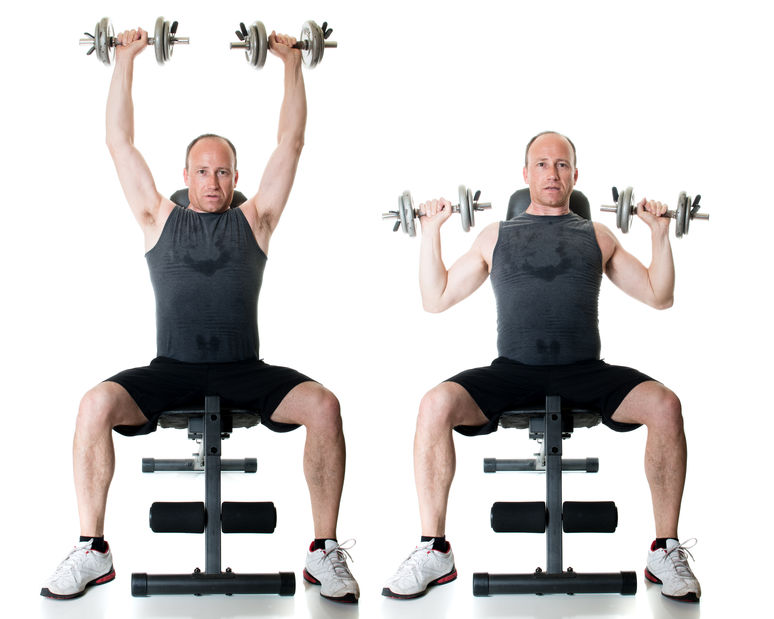
The training approach known as Time Under Tension (TUT) has gotten lots of attention in the bodybuilding and strength training arenas as of late. Many swear by its benefits while others skip it in favor of conventional rep-range training instead. While there may continue to be a debate to how useful TUT is with a healthy, active population, having employed this training method with clients diagnosed with Multiple Sclerosis (MS), I can attest to its benefits, especially with this population.
My particular training style challenges folks with MS to simply push their own bodies in the ways their nerve disorder would like to prevent. I believe that through resistance training people with MS can build and strengthen their muscles well enough to perform activities of daily living efficiently as well as performing compound lifts in the gym that they may have previously thought was not possible. I’ve employed this approach and seen it work well.
The key to successful strength and muscle growth is being certain that the program includes progressive overload. A muscle will only grow in strength and size when the demands placed on it are continuously increased. A muscle that is not progressively challenged will stall out, but when it is pushed beyond the limits of its last task, that’s when it will grow.
By focusing on timed sets rather than going for a specific number of reps, you can directly influence the intensity of the set and stimulate results in the form of stronger muscles.
What Is Time Under Tension Training?
TUT refers to how long a muscle is under strain, or really, under a weighted load, during a set (tension has other implications but this is the acceptable term). For most people, depending on pace preferences, a typical set of 8 to 10 reps can be performed in anywhere from 15 to 25 seconds. The current muscle growth theory states that by loading the muscle for a longer time, typically from 35 to 120 seconds, the metabolic activity in the muscle cell will result in increased size.
There is some variance and disagreement over what really constitutes adequate time under load to qualify it as a TUT set. The research is limited at this time and rooted mostly in theory about creating a hypoxic (blood-restricted) environment that ultimately creates muscle growth. This kind of blood restriction traps metabolites, which are believed to cause the muscle stress that spurs on growth. The longer this hypoxic environment is created, theoretically, the more stress to the muscle, and—you guessed it—the more the muscle will grow.
Theoretically. Lots of research out there has conflicting evidence of which rep ranges and time under tension results in the most muscle growth.
So for me, it becomes more important to draw from my experience training thousands of clients over 40 years to conclude that a repetition pace of six counts up and six counts down is worth doing.

The Role of Type I and Type II Muscle Fibers
Skeletal muscle can be categorized into two different types of fibers: Type I and Type II. Type I, often referred to as slow-twitch fibers are responsible for endurance performance such as distance running and cycling, while Type II fibers, also called fast-twitch fibers, are recruited for activities requiring strength and power, such as sprinting and weight lifting.
To decide if TUT is a type of training worth incorporating, we have to determine if TUT is actually growing and strengthening any muscle fibers.
A 2014 study recruited two groups of lifters, one lifting heavy and for a shorter time under load, and the other lifting lighter but for a longer time under load. Although, the first group resulted in greater size and strength gains overall, results illustrated that increased TUT caused more Type I fiber growth while shorter TUT caused more Type II hypertrophy. That’s an outcome not to be overlooked.
I have personally witnessed this in the context of my own training as someone living with MS and also in the training results of many of the participants of my 12-week MS fitness challenges.
Incorporating TUT in Your Own Workouts
Incorporate the below routine which I myself use to reap the benefits of TUT training:
- Start with a simple movement like a bicep curl to get used to the process.
- Select a weight that you can complete in 8 to 12 repetitions per set. TUT places higher demands on your muscles; if you are accustomed to 20-pound dumbbells for bicep curls, you may only be able to use 15 pounds with TUT training.
- The tempo for the lift will be 6 counts on the concentric and 6 counts on the eccentric. Keep your eye on a second hand or even set a metronome to be sure you don’t speed up!
- Perform three sets for each exercise with 30-60 seconds rest in between sets.
There are many ways of working out and getting results in the gym. I have found that rotating and cycling workouts prevents boredom and keeps your muscles from getting “lazy”.
TUT is only one of many approaches to stimulate muscle strength and growth. Normally I employ TUT workouts for about a month before I switch to a different training program utilizing advanced training techniques.
Take-Home on TUT
At the end of the day, my position is that utilizing various training methods will be most successful when endeavoring to develop strength, grow muscles, and most importantly, to prevent muscle wasting in people with MS.
TUT is certainly not the end-all and be-all training methodology. Yet, incorporating it into any client’s routine can provide benefits, and certainly, into any MS fitness programming specifically, will yield the most well-rounded results, in my opinion.
A hallmark symptom of MS is fatigue therefore, doing everyday activities that require endurance such as vacuuming, which can be taxing on the upper body, or simply walking, is more demanding of Type I fibers as opposed to Type II. Proper TUT training can help combat the MS-related fatigue associated with these types of activities. Making sure Type I endurance fibers are well-developed and strong should be a high priority.
If you’d like to learn more about how to coach clients suffering with MS, click the banner below for more info.
 DAVID LYONS was diagnosed with multiple sclerosis (MS) in 2006 at the age of 47. A bodybuilder and former owner of fitness centers, Lyons made the choice to fight MS head-on through bodybuilding. He founded the MS Bodybuilding Challenge in 2008, and in 2009, at age 50, competed in his first bodybuilding contest with MS, winning a Most Inspirational trophy. In 2012, Lyons and his wife created the MS Fitness Challenge to support people with MS in their efforts to stay as fit as possible, overcome limitations, and keep their bodies moving.
DAVID LYONS was diagnosed with multiple sclerosis (MS) in 2006 at the age of 47. A bodybuilder and former owner of fitness centers, Lyons made the choice to fight MS head-on through bodybuilding. He founded the MS Bodybuilding Challenge in 2008, and in 2009, at age 50, competed in his first bodybuilding contest with MS, winning a Most Inspirational trophy. In 2012, Lyons and his wife created the MS Fitness Challenge to support people with MS in their efforts to stay as fit as possible, overcome limitations, and keep their bodies moving.
References:
www.researchgate.net/publication/282003004_Optimization_of_training_development_of_a_new_partial_load_mode_of_strength_training







